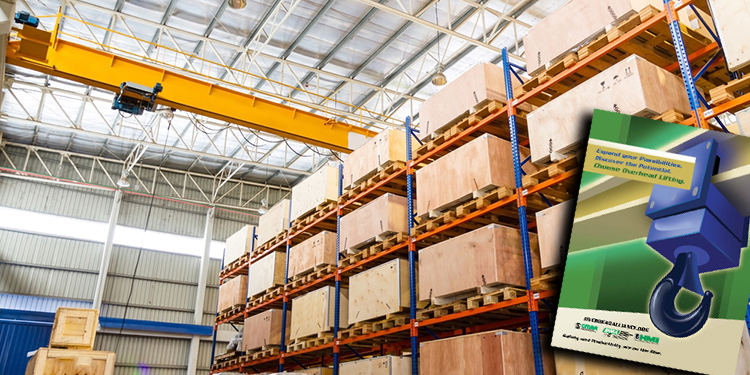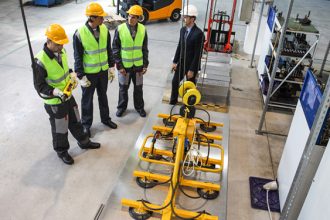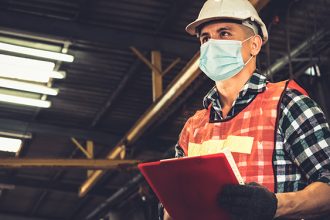Reduce Costs Across Five Areas By Deploying Overhead Lifting Solutions

This is the sixth in a series of posts detailing 13 reasons why overhead lifting and handling technologies — specifically cranes, hoists, and monorails — can improve a manufacturing or distribution operation’s efficiency, productivity, safety, and sustainability. Read more in the free Overhead Alliance publication, “Expand Your Possibilities. Discover the Potential. Choose Overhead Lifting.”
Deploying one or more overhead lifting solution—such as cranes, hoists, monorails, and workstation cranes—can significantly reduce operating costs in a variety of ways. That’s because engineers design these systems to match a broad range of product handling needs within a warehousing or manufacturing facility. That customization ensures optimized operational productivity and greater process efficiency. The result? A positive impact across five key cost centers, through:
1. Overhead Lifting Systems’ Low Maintenance Requirements
Overhead lifting solutions require less frequent maintenance than other types of material handling equipment utilized for load transport, manipulation, positioning, and placement. Constructed with fewer moving parts, overhead equipment service and upkeep is faster and less complex. Both of these factors contribute to an overall reduction in downtime, labor, service parts, consumables, equipment wear, and other costs associated with system maintenance and repair.
2. Less Dependence on Transport Vehicles and Labor.
With just one overhead lifting system capable of covering a large work area, an operation can replace multiple floor-based load handling vehicles. The installation of a crane, hoist, or monorail solution enables redeployment of existing vehicles elsewhere within a facility (or eliminated completely). Further, as overhead handling equipment requires just one operator to control and direct load movement, employees previously dedicated to driving these vehicles can be reassigned to other, more value-added tasks. This cuts both load movement costs and positively impacts the bottom line.
3. Decreased Product Damage with Overhead Lifting.
Overhead lifting solutions greatly minimize the risk of product (and facility) damage when compared to product movement via floor-based vehicles. They avoid collisions by providing direct-path transportation over the top of any obstacles, as well as self-center each load to prevent it from overturning and control its movement with multiple speed options. This increased degree of load control dramatically lowers the chances of—and costs associated with—product damage. Cranes, hoists, and monorails are particularly ideal for moving large, odd-shaped loads that floor-based vehicles cannot handle. Further, many overhead handling systems allow for extremely precise positioning. This significantly reduces the risk of damage to tooling parts, components, blanks, or finished products when loading and unloading production machines and related equipment.
4. Overhead Lifting Improves Worker Safety.
Because overhead handling solutions are designed to lift, lower, move, and position loads ranging from 50 pounds to 50 tons (or more), they eliminate the risk of workers suffering an ergonomic injury resulting from manually lifting, pushing, or pulling heavy loads. This equipment is also restricted to a specific area, making an operation safer by limiting worker exposure to the accidental impacts and collisions associated with floor-based load moving vehicles. By removing the load from the path of employees, these lifting systems contribute to a reduction in injuries, accidents, missed workdays, workers’ compensation costs, downtime, and a host of other direct and indirect costs.
5. Better Facility Utilization.
By choosing to use floor-based transport and placement equipment, many warehousing, distribution, and manufacturing facilities miss the opportunity to maximize the overhead space in their buildings. Overhead lifting solutions, however, can stack loads higher because they can reach higher elevations. This maximization of vertical space enables an operation to optimize the cubic volume of an existing building to handle more products without needing to acquire more land or facilities. Additionally, because cranes, monorails, and hoists move a load directly from one location to another overhead (without having to navigate through or around aisles, columns, equipment, pallet racking, and other obstacles), they reduce overall transport time and increase operational productivity, throughput, and efficiency.
What other cost savings can your operation expect to achieve by deploying an overhead lifting system?
Get answers in the free publication, “Expand Your Possibilities. Discover the Potential. Choose Overhead Lifting,” produced by MHI’s Overhead Alliance (which includes the Crane Manufacturers Association of America (CMAA), the Hoist Manufacturers Institute (HMI), and the Monorail Manufacturers Association (MMA)).



